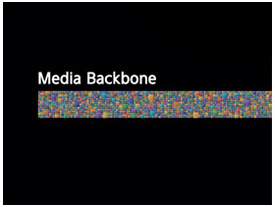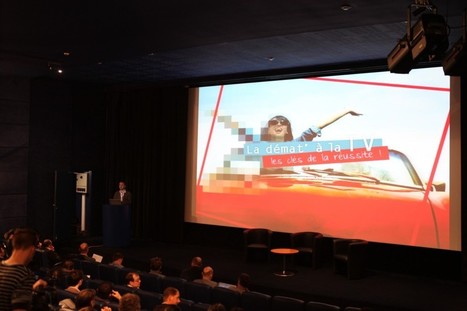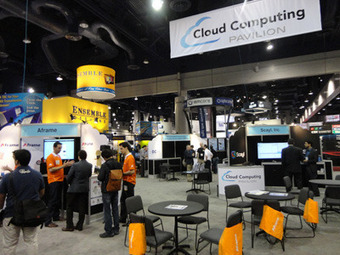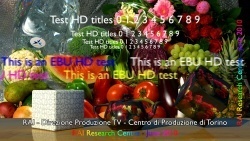 Your new post is loading...
 Your new post is loading...
The reign of end-to-end OTT platforms is over, here comes the modular OTT Platform ! With SOA, FIMS, IMF and DASH, agility time has (almost) come... This is the report/sequel of Vimond's Industry Visionaries IBC2013 talk about “The Future of OTT Platforms: Is it Diversification or Standardization ?” with Eric Schumacher-Rasmussen, Editor of Streaming Media Magazine, and Nicolas Weil.
Digital Workflow isn’t the most gripping of subjects I’ll admit, but as tapes finally disappear from our production process it’s important to recognise that files can be troublesome things that require careful management. Fortunately the market has spotted the opportunity and there are now a significant number of products available that will manage your workflows - anything from a drop folder into your favourite transcoder, to a multi-stage system with many components doing hundreds of transactions every minute. The one thing all the systems have in common is that they package bits of kit made by other vendors and present them to you as part of a co-ordinated workflow. To make this happen each of the applications or bits of kit – transcoders, QC boxes, loudness normalisers, that sort of thing – provide a software interface to the workflow system that allows them to talk to each other. The problem is that all of these interfaces are proprietary and different, so every time you need to add a new box, or a new feature to an existing box, code in your system needs to be rewritten. As the systems get more complex – as they will for many of us - so the problem gets worse.
What has business process management got to do with broadcasting? Surely, it is more relevant to a manufacturing operation; broadcasting is a creative business, isn’t it? Sure, production is creative, but to an outsider, broadcasting operations are much like manufacturing. Raw materials — the program tape or file — arrive from the production company, and at the other end, the broadcaster delivers programs to the viewer. Through all the many processes, the program has been formatted for the viewer’s television, tablet or smartphone, and any necessary subtitles, captions or dubbed audio have been added to the program. The channel schedule has been delivered to the third-party listings guides with information about each program, and the promotions department may also have created trailers for the program. Is this not a manufacturing operation, a media factory? Over the last decade, many verticals outside the media-and-entertainment sector have moved to a software architecture where the processes are managed as a whole, rather than using islands of software to process the product. This holistic management of business processes potentially offers a more efficient way to command, control and optimize media operations.
The Framework for Interoperable Media Services (FIMS) will be awarded the Judges’ Prize at IBC2012. The project is a joint initiative between the Advanced Media Workflow Association (AMWA) and the European Broadcasting Union (EBU). Recently FIMS celebrated both the publication of version 1.0 of its specification and its first large-scale implementation by Bloomberg Television. With the broadcast industry moving towards file-based file exchange and production infrastructures, there was a pressing need for industry standardization on the way that core metadata should be stored and presented. The real benefits of file-based technology can only be realized if there is a seamless interface between the installations of different producers and broadcasters, and between the products of different vendors.
FIMS 1.0 is composed of the following parts: - FIMS 1.0 Part 1 - FIMS 1.0 Part 2 (specification) - FIMS 1.0 XSDs and stubs A reference software implementation has now been provided by IBM. The 3 media services defined in FIMS 1.0, i.e. 'transfer', 'transform' and 'capture' are available in both Java and .Net environments.
The MPEG-7 AudioVisual Description Profile (AVDP) has become a new ISO International Standard. The profile is specially designed for representing and exchanging metadata generated by automatic extraction tools, such as speech-to-text transcription engines and videoshot detection algorithms.
The Unified Media Services (UMS) toolkit provides a simple way for media services from multiple vendors to be integrated into a single, comprehensive asset management and delivery platform. "With today's keen commercial awareness, content owners and broadcasters need their asset management systems to be much more than simple libraries," said Tony Taylor, chairman and CEO of TMD. "They need to integrate media services from ingest through transcoding to cloud storage and content delivery networks, and they need to synchronise rich metadata with multiple databases. This is something we have been building for years, but with the introduction of UMS we have simplified the process based on open standards." UMS is an architecture with an API, based on web services. It enables external media services devices, whether using their own proprietary interface or an open, FIMS-style adaptor, to be integrated on a single, media-aware workflow bus. It eliminates the need for visibility of any individual proprietary API, enabling the system designer to create workflows based entirely on services.
The broadcast industry is in the midst of a quantum leap to a more highly evolved, flexible, and efficient way of working. Experts say this transformation is crucial if we want to successfully manage the growing demands of a multistandard, multiplatform content distribution model.
At last year's NAB and IBC shows several vendors, including Avid, IBM, Cinegy, Sony and Cube-Tec collaborated on a "proof of concept" demonstration showcasing interoperability between several FIMS compliant devices. But at the 2012 NAB Show, show-goers will see a real-world FIMS workflow that's been successfully implemented at Bloomberg Media. "We're also hoping to finalize and ratify the first version of the FIMS specification by NAB," said Claman.
1st Quarter 2012 Video Breakthroughs Events List
Broadcasters no longer have the monopoly on the delivery of A/V entertainment to the home. In the fiercely competitive world of media and entertainment, companies have to deliver more versions and formats, but without increasing their costs. A channel is now expected to have a Web presence, as well as mobile and tablet versions of their content.
Organizations like the EBU and Advanced Media Workflow Association (AMWA) are promoting the service-oriented architecture (SOA) as a route to provide the interoperable media services that can serve the new business requirements.
For the seasoned video engineer, the world of SOA introduces terms and concepts that at first encounter seem foreign and more suited to the IT specialist. As video processing migrates to the file domain, there is no option but to become familiar with what at first sight may appear alien.
Broadcast systems have evolved around the imposed workflow of the serial processing steps of videotape operations. Over time, many processes have moved from dedicated hardware boxes with SDI in and out to software applications on a network. A typical broadcast operation is now a hybrid of SDI and IP connections.
In many cases, the workflow remains as the original tape-based flow. Over time, other applications like asset and workflow management are layered over the entire process chain. The system has grown by accident, not by design, and become a web of custom or proprietary interfaces linking the many applications.
Sure it works, it was designed that way, but when the time comes to replace a component part — say the playout automation — the inflexibility of the system rapidly comes apparent. The parts of the system are linked by a web of custom APIs, often restricted to a specific release of a specific software application. It is just not possible to swap out the automation for the latest product without attending to the web of interfaces.
To meet the demands for new services to the public, the broadcaster must add facilities for a mobile news service, a 3-D channel and interaction with a social media website. Along comes CES and some new consumer device to consume content. How do you add support for this new device? Will it mean more custom interfaces or more special workflow applications? The EBU and AMWA are developing a Framework for Interoperable Media Services (FIMS), which aims to provide a new technology platform that leverages current IT practices, like the use of the SOA, to provide business agility and to control costs.
With the digital media ecosystem remaking business models and putting a greater premium on operational efficiency than ever, the industry’s leading advocates for user-requirements identification, business-driven solutions, and worldwide standards – the Advanced Media Workflow Association (AMWA), the European Broadcast Union (EBU), and the Society of Motion Picture & Television Engineers (SMPTE) – today announced that they will work together to accelerate their respective efforts at driving interoperability and delivering efficient media workflows. FIMS Task Force Output Moving Toward Formalization
The EBU and the AMWA also announced today that the output of the Framework for Interoperable Media Service (FIMS) Joint Task Force will be submitted to SMPTE after formalization by AMWA and EBU. The organizations formed the task force in 2009 to address system integration issues in modern and complex TV production environments and recently demonstrated some early capabilities this effort at IBC 2011.
Framework for Interoperable Media Services : FIMS White Paper [PDF]
Currently in the media industry, users are implementing service-based systems using proprietary systems with bespoke software ‘glue’ holding it all together. They are doing this without an open, agreed framework and without standardized interfaces. While several organizations have identified a number of common processes such as capture which are performed essentially the same way throughout the industry, users are implementing these processes as services in different ways. At the same time, technology vendors are responding to demand for services-based products, but interoperability between different implementations is non-existent. This is because there is a lack of an agreed framework and publically developed service definitions in the media industry. The AMWA-EBU FIMS (Framework for Interoperable Media Services) Task Force was established in December 2009. FIMS is a framework of service definitions for implementing media related operations using a Service-Oriented Architecture (SOA) approach. Media companies deploying this framework can expect that doing so will promote interoperability and reusability of services. FIMS defines service models with associated management, error handling, communication, and time awareness. To properly exploit this technology the Task Force has developed a common framework which will help ensure integration interoperability, interchangeability and reusability of services. This will drastically reduce integration costs, allow users to more freely choose the most appropriate products on the market at any given time, improve maintainability, and aid in the adoption of new technologies. FIMS also has begun the process of defining open services that are loosely coupled thereby enabling multivendor services to be integrated and creating “best-in-class” media systems. The services can span a wide domain of operations and permit integration of FIMS into business and management systems. The bottom line is that implementing FIMS will move facilities to an agile environment that is more easily configured, modified, managed and governed compared to non SOA systems. Read the full whitepaper here : http://wiki.amwa.tv/ebu/images/1/12/FIMS_WhitePaper_Version_1.0.1.pdf
“Conductor” plays a key role in Sony's new Tapeless initiative called Media Backbone. Based on a Service Orientated Architecture (SOA) Media Backbone enables heterogeneous platforms and applications to be easily integrated and managed via a common Enterprise Service Bus (ESB). The benefits of an efficiently run, modular, scalable system are open-ended. A layered, abstracted system that can be viewed from a high level can be automated to an extreme degree, and integrated seamlessly with external services and consumers. Sony's experience with metadata-driven workflows is the key to integrating the proven benefits of SOA with a media production system.
|
A practical approach to standardization requires more than object models and interface definitions to gain serious traction. Consequently, the FIMS Technical Board recognized the need for a tool to help FIMS implementers validate their implementations. Signiant did as well, given the test-driven development methodology we use to develop software. Using such an approach, developers create and code tests to validate an implementation before coding it. This leads to higher quality products that can be evolved quickly. Signiant initiated the FIMS Test Harness Project within the FIMS Technical Board and helped design and build a test harness for contribution to the FIMS effort. The ultimate goal of the test harness is to remove barriers to FIMS adoption and promote implementation of FIMS-compliant interfaces.
Le 17 octobre s’est tenu dans l’auditorium de Francetélévisions un Atelier Dig-it intitulé « Dématérialisation des contenus à la TV : les clés de la réussite ! » réunissant les meilleurs spécialistes français de la question, ainsi que plusieurs experts internationaux.
The wide adoption of FIMS will gather further momentum here at IBC today, when the collaborative group behind it collect the IBC Judges Award, and SMPTE and the EBU announce an acceleration of the standardisation process. Asked what is new for the show, Jean-Pierre Evain, the EBU FIMS co-ordinator (pictured), said: “On one side, more members like Signiant and Dalet. From the specification point of view, we are working on repositories and cloud management in FIMS, and defining requirements for quality assurance.” The users have spoken, and the high priority idea is a repository service. What is next? “Getting different orchestration systems to work together,” saidAMWA executive director Brad Gilmer.
SOA-based archiving process for News - proof of concept (IRT study)
The concept of service-oriented architecture (SOA) is currently being introduced in professional broadcast environments. It offers, in principle, a more effective way of integrating systems in a production platform.
This article illustrates the concept of SOA and describes an actual implementation that has been used in a proof-of-concept study. This study demonstrated the archiving of news as an integrated end-to-end process. The experience gained gives an insight into where, as an integration platform, the benefits of service-oriented architecture lie ... and also where specific challenges might arise.
READ PAPER HERE : http://tech.ebu.ch/docs/techreview/trev_2012-Q2_SOA_archiving_Elser.pdf
EBUCore was first published in 2000. It was originally a set of definitions for audio archives, applied to the Dublin Core, which is itself a generic set of descriptive terminology that can be applied to any content. XML was then in its infancy but its use would grow dramatically, demanding more structured information to describe audiovisual content. Since then, other semantic languages have greatly influenced the way this information is modelled. EBUCore followed this evolution to become what it is today: the Dublin Core for media, a framework that can be used to describe just about any media content imaginable. The EBU-AMWA FIMS project (wiki.amwa.tv/ebu), creating a vendor-neutral specification to interconnect production equipment, has adopted EBUCore. The FIMS 1.0 specification uses EBUCore as its core descriptive and technical metadata. FIMS is a vital project for the future of file-based production and feedback received from participants has influenced the most recent version of EBUCore. Early adopters of FIMS, such as Bloomberg, are using this metadata.
NAB 2012 closed its doors two weeks ago, so it’s a good time to draw an appraisal on various themes concerning OTT issues, and especially premium OTT issues, that have been handled through industry technology offer during the tradeshow. Here we’ll go from production to distribution and examine the salient NAB facts and products, at least the ones which have a potential influence on OTT workflows evolution in the coming months (or years ?).
VSN will present the next generation MAM solution VSNEXPLORER. Attendants will see a completely re-designed BMS solution (VSNCREATV) featuring a powerful business-oriented report and dashboard tool. VSN will also display new versions of VSN's automation, graphics and workflow management solutions that create a top-performance, yet cost-effective, 'Channel-in-a-box' system for all needs. This new solution is the peak of the Spider project, the VSN framework based on FIMS project.
Tying it All Together : A watershed moment in the Media Industry
Viewers have seen several step changes in the evolution of television, analog to digital, standard to high definition, and if you go back far enough, monochrome to color.
There have been similar changes on the production side, but those that have had most impact are the changes from film to videotape and analog to digital processing, the introduction of HD, and now the migration to file-based operations.
The migration from physical media to files processed on computer platforms presents opportunities and a new flexibility, but potentially adds complexity. You need systems that work together, and converting to file-based technology only gets you part of the way there.
Agreed file formats are necessary, but not sufficient to build digital facilities. To simplify file-based operations many media companies are adopting a service-oriented architecture. For the future the ‘cloud’ beckons, abstracting the services from geographical constraints.
The key to reusable services in the cloud lies in agreed standards and specifications that can enable interoperability.
READ THE PAPER HERE : http://www.amwa.tv/downloads/whitepapers/Tying_it_Together-Gilmer.pdf
During this webinar, FIMS activities were presented in details inc. a reminder on the open conditions to be a member, an introduction to the project working procedures, the FIMS 1.0 specification demonstrated at NAB and IBC 2011, as well as future plans. Presentations have been given by the project Chairs and managers: Giorgio Dimino – RAI, John Footen – Cognizant, Paul Gardiner – Sony, Brad Gilmer – AMWA and Jean-Pierre Evain - EBU.
Are integrated production architectures mature for commodity use, and will 1080p50/60 HDTV become mainstream? David Wood and Hans Hoffmann, who lead the EBU’s technical department, look at likely short- and mid-term developments. For a number of years two major trends have emerged in programme production. The first is the development of digital workflows that improve production efficiency and reduce costs through flexible, commodity IT-based production architectures. Current equipment can be made interoperable using the ‘media orchestration system’, with a FIMS adapter that converts the capturing or processing device interface to a common interface standard. New equipment can include the FIMS interface; the specification is now ready.
At the recent IBC Show in Amsterdam, numerous vendors were extolling the benefits of a service oriented architecture (SOA) for capturing, producing, processing and distributing video and audio content as digital files. It’s the latest industry buzz term, but this one appears to have staying power as it brings the potential cost- and resource-saving benefits for both customers and the manufacturers themselves. Although clearly interested, many attendees were left feeling a bit cautious about how to most effectively design and implement such an IT-centric system, even with the knowledge that it would increase efficiency and staff productivity while helping content providers manage the transition to a multi-screen, multi-format universe.
Marquis Broadcast is unveiling major new upgrades to Medway, its media transfer and format conversion software, at IBC 2011. The upgrades feature a range of metadata integration enhancements that bring further efficiencies to file-based broadcast and post-production workflows. Two new major advancements within Medway due for release later this year are being presented at IBC 2011. The first is a new web services interface, based on the AMWA/EBU FIMS development that will enable MAM systems to drive Medway’s feature-set. The second new development will provide closed caption preservation throughout editing workflows, and metadata support for the frame accurate requirements of 3-D/proxy production.
|



 Your new post is loading...
Your new post is loading...

![[IBC 2013 Talk] The Future of OTT Platforms | Video Breakthroughs | Scoop.it](https://img.scoop.it/QcV918WTWh5B0iROqlVSxDl72eJkfbmt4t8yenImKBVvK0kTmF0xjctABnaLJIm9)












![Framework for Interoperable Media Services : FIMS White Paper [PDF] | Video Breakthroughs | Scoop.it](https://img.scoop.it/3wbB31kLNiKwnOisLmJzRTl72eJkfbmt4t8yenImKBVvK0kTmF0xjctABnaLJIm9)


















